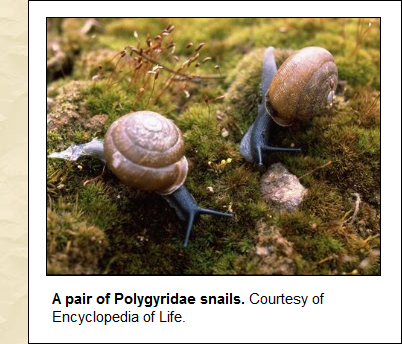Description
Classification
Habitat
Diet
Reproduction
Gallery
References
Contact

Reproduction
There is little information available regarding the reproductive characteristics of Millerelix or Millerelix fatigiata, so reproductive information on this page will be from Glenn R. Webb's paper The Sexology of Polygyra septemvolva Say, Life-History Notes, Possible Utility, and Data on Stenotrema (Mollusca, Gastropoda, Pulmonata, Polygyridae), which describes the reproductive characteristics of the more widely known species Polygrya septemvolva - a snail that belongs to the Polygyridae family as does Millerelix. All members of Polygyridae, however, are monoecious, meaning each individual has both male and female sex organs.
Courting Behavior - Courtship in Polygrya septemvolva begins with two individuals meeting “head-on,” each snail retracting its tentacles as the other comes closer. Once sufficiently close enough to each other, the snails will shift their bodies in such a way that their penises (which previously everted) are adjacent. At this point the penises continue to evert (much more rapidly, however) and begin to coil around each other. At this point the snails will oftentimes start to chew at the base of the other’s penis. This chewing sometimes causes one of the snails to withdraw, but commonly one of the snails will simply fail to maintain synchronization with the partner. If this is the case, the snails will readjust their positions and engage in a sort of fighting-match in which each bites at the other. A bitten snail will pivot and then re-engage the other snail, and this behavior is continued until the pair is able to successfully mate. This usually takes less than a dozen such “pivotings” (Webb 1950).
Copulation - Although the two snails’ penises are initially coiled upwards around each other, they later unwind slightly so that the ejaculatory tip of each snail is against the penis of the other, usually near the pouch. The final stage of mating consists of the mutual exchange of semen, which is ejaculated onto the other snail’s penis in this area. Chewing does not occur during this stage of mating, but this behavior is seen again just before or as the snails are separating from each other. Separation begins after about 3-12 minutes, and the snails start to uncoil from each other and their penises begin to retract. As each penis retracts, the basal part envelops the partner’s semen (Webb 1950).
Hatching and maturation - Polygrya septemvolva eggs can be found about 10-30 days after mating. The eggs are at least 1.5-2.0 millimeters in diameter, are slightly ellipse-shaped, and have a flexible, opaque shell. About 4-9 eggs each are laid in a nest, which is commonly located underneath something or in a dugout covered with soil. In about 40-45 days the eggs will hatch, and the newly hatched Polygrya septemvolva snails will be around 1.5 millimeters in diameter or larger. The young snails develop to maturity in less than 144 days after hatching, ready to begin the cycle over (Webb 1950).